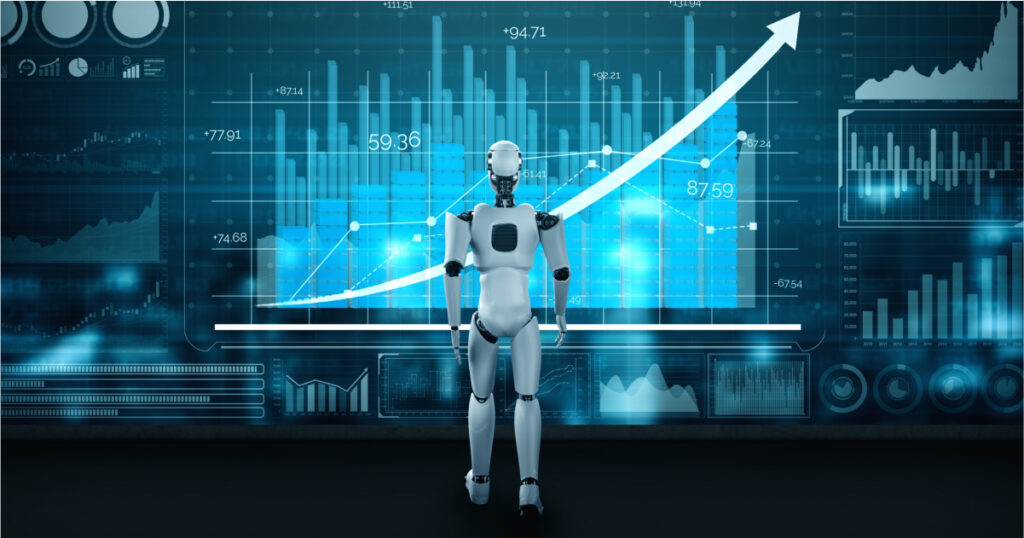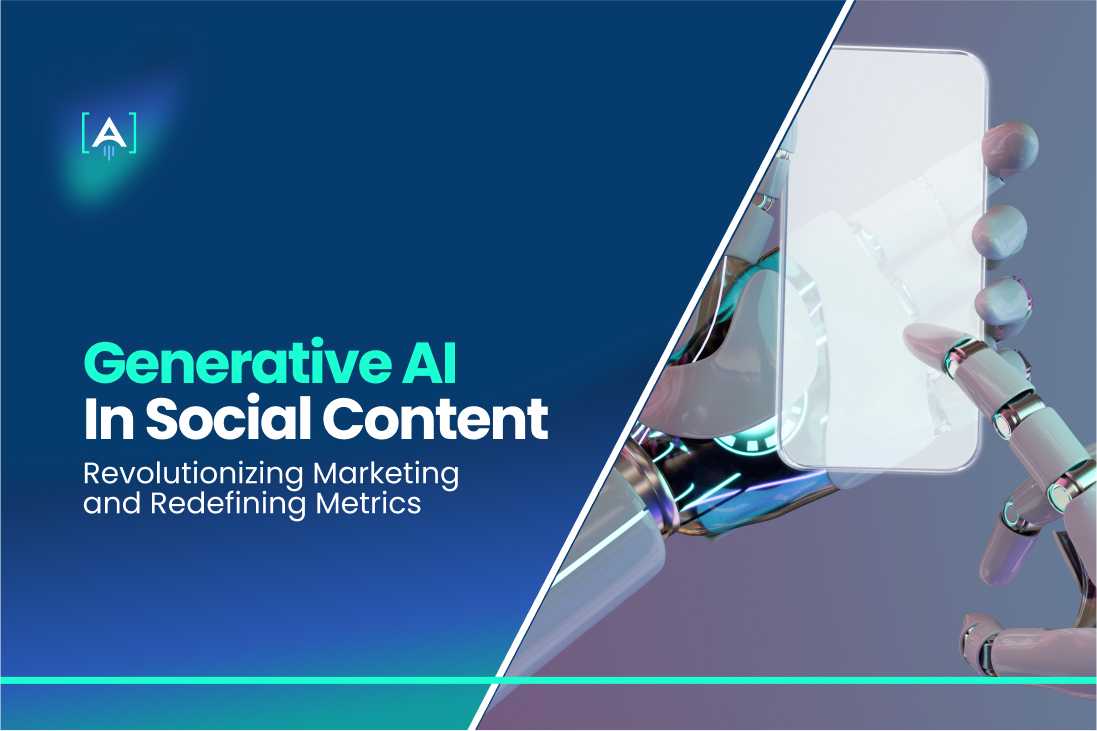The emergence of Generative AI marketing has ushered in a new era of innovation and efficiency.
Generative AI is a subset of artificial intelligence that involves machines that can autonomously produce content by learning patterns from vast datasets, whether text, images, or other forms.
Download Your Free Resource
Generative AI is increasingly gaining traction in marketing circles, and its impact on social media content creation and analytics is reshaping the strategies employed by brands worldwide.
The traditional methods of creating and disseminating content on social media platforms are undergoing a paradigm shift with the infusion of generative AI marketing.

Such tech empowers marketers to craft compelling narratives and visually captivating material at an unprecedented speed and scale.
As a result, businesses can engage their target audience with relevant and personalized content, enhancing brand visibility and fostering meaningful connections.
Join us in unraveling the journey of Generative AI in Social Content Marketing – a revolution that promises to reshape the marketing world as we know it.
Understanding Generative AI

Definition and Explanation of Generative AI
Generative AI fundamentally revolves around generating new, authentic content that mimics the patterns observed in the training data.
Unlike traditional AI systems based on pre-programmed rules, generative models can create content not explicitly defined in their training datasets.
This autonomous creativity is achieved through algorithms that enable machines to understand and replicate patterns, producing novel, human-like content.
When paired with Semantic SEO, generative AI can also enhance content relevance by aligning it with user intent and context, improving search visibility.
Key Technologies and Algorithms Powering Generative AI
Generative Adversarial Networks (GANs)
GANs are at the forefront of generative AI, introduced by Ian Goodfellow and his colleagues in 2014. This framework consists of two neural networks, a generator and a discriminator, engaged in a continuous adversarial process.
The generator aims to produce content, such as images or text, while the discriminator evaluates the authenticity of the generated content. This iterative process results in the generator continuously improving its ability to create content that is indistinguishable from accurate data.
Machine Learning Models
Generative AI heavily relies on machine learning models, leveraging vast datasets to learn patterns and relationships.
These models employ techniques such as deep learning to understand complex features in data and generate content that aligns with the learned patterns.
Machine learning forms the backbone of generative AI, from natural language processing models for text generation to image-generating models like Variational Autoencoders (VAEs).
Recurrent Neural Networks (RNNs) and Transformers
RNNs and Transformers, such as text or time-series data, are pivotal in sequential data generation. RNNs can process sequential information, making them adept at generating coherent text passages.
On the other hand, transformers excel in capturing long-range dependencies and have proven instrumental in various generative tasks, including language translation and image synthesis.
Generative AI in Content Creation

The integration of Generative AI marketing has sparked a revolution in how brands interact with their audiences.
How Generative AI is Used for Creating Social Media Content
Text Generation
Generative AI marketing includes crafting compelling text content for social media. Natural Language Processing (NLP) models, such as OpenAI’s GPT-3, are adept at generating coherent and contextually relevant text.
From crafting engaging captions to generating entire blog posts, these models have become invaluable tools for marketers seeking to enhance their textual content effortlessly.
Image Synthesis
Generative models like Generative Adversarial Networks (GANs) are at the forefront of image synthesis. They can produce high-quality, realistic images that align with predefined criteria.
Brands leverage this capability to create visually stunning graphics, product visuals, or personalized photos that resonate with their target audience.
Video Production
The fusion of generative AI with video creation is transforming how brands approach visual storytelling. AI-powered video synthesis enables the automatic generation of videos based on specific themes, styles, or even targeted audience preferences.
This innovation allows marketers to streamline video production and maintain a consistent brand narrative across various channels.
Case Studies of Brands Successfully Using AI-Generated Content
- Burberry – Personalized Fashion Campaigns
Burberry employed generative AI marketing to create personalized fashion campaigns tailored to individual customer preferences.
- Adobe – AI-Enhanced Creative Tools
Adobe incorporated generative AI marketing into its creative tools, empowering users to effortlessly generate visually stunning graphics, illustrations, and designs.
- DALL-E by OpenAI – Visual Storytelling
OpenAI’s DALL-E, a GAN-based model, demonstrated its prowess in generating diverse and imaginative images based on textual prompts.
- Netflix – Personalized Thumbnails
Netflix employs generative AI marketing to dynamically generate personalized thumbnails for its content based on user preferences.
Enhancing Creativity and Efficiency
Generative AI is reshaping content creation, not only by fostering creativity but also by significantly boosting efficiency.
AI’s Role in Enhancing Creativity
Imagination Unleashed
AI models respond to creative prompts, enabling marketers to explore new realms of imagination. For instance, a travel brand could use AI to generate compelling, personalized travel narratives by providing destination-specific prompts.
Diverse Content Creation
AI algorithms offer diverse content styles and formats. Imagine a fashion brand leveraging Generative AI marketing to generate a range of creative product descriptions, experimenting with different writing tones and appealing to various audience segments for a more inclusive marketing approach.
Personalization at Scale
AI analyzes user data to tailor content. Consider an e-commerce platform utilizing AI to recommend products based on individual preferences and purchase history, creating a more personalized shopping experience.
AI’s Role in Enhancing Efficiency
Automated Content Generation
AI-driven tools automate content creation, saving time and effort. A social media management tool powered by AI could automatically generate engaging post captions, allowing marketers to focus on strategic planning and audience engagement.
Consistency Across Platforms
Generative AI ensures consistency by producing content aligned with predefined brand guidelines. A multinational brand could use AI to generate visuals tailored for each cultural context, maintaining a consistent brand image across diverse social media platforms.
Data-Driven Decision Making
AI enables data-driven decision-making. A content marketing team might use AI content intelligence to analyze user engagement data, helping them refine content strategies and deliver more relevant and impactful material to their target audience.
Personalization and Targeting Through Generative AI

AI-Driven Personalization Techniques for Social Media Content
Dynamic Content Recommendations
Generative AI marketing helps analyze user preferences and behavior to provide dynamic content recommendations.
For example, an online streaming service uses AI to suggest personalized playlists or movie recommendations based on a user’s viewing history.
Adaptive User Interfaces
AI tailors user interfaces dynamically, adapting based on individual interactions.
A news app might use AI to personalize the content layout, prioritizing topics of interest for each user to enhance engagement.
Automated Email Campaigns
AI automates the personalization of email campaigns by analyzing user interactions.
An e-commerce platform might utilize AI to send targeted emails featuring products based on a user’s browsing history and purchase patterns.
Impact of AI on Audience Segmentation and Targeted Marketing
Granular Audience Segmentation
AI refines audience segmentation by analyzing vast datasets, allowing for more granular categorization.
An apparel brand could use AI to identify and target niche customer segments based on specific preferences, improving the precision of marketing efforts.
Real-Time Targeting
AI enables real-time targeting by continuously analyzing user behavior.
An online retailer might instantly use AI to adjust advertising strategies, ensuring that promotions align with the latest trends and consumer preferences.
Predictive Analytics for Campaign Optimization
AI utilizes predictive analytics to optimize marketing campaigns.
A technology company might employ AI to forecast which ad creatives are likely to resonate with specific audience segments, enhancing the effectiveness of their campaigns.
Ethical Considerations and Privacy Concerns in AI-Driven Personalization
Data Privacy
The extensive collection and analysis of user data raise concerns about data privacy. Businesses must ensure transparent data practices and obtain informed consent to address privacy issues related to personalized advertising.
Algorithmic Bias
AI algorithms may inadvertently perpetuate biases present in training data, leading to unfair targeting. Regular auditing and refinement of algorithms are essential to mitigate biases and ensure fairness in personalization.
User Consent and Control
Balancing personalization with user consent and control is crucial. Companies must empower users to control the extent of personalization they experience, respecting individual preferences and privacy boundaries.
Revolutionizing Engagement Strategies with AI

AI’s Role in Crafting Engaging and Interactive Social Content
Dynamic Content Tailoring
AI analyzes user behavior and preferences to dynamically tailor social media content.
For instance, an online fashion retailer might use AI to showcase personalized product recommendations and styling tips, enhancing user engagement.
Interactive Chatbots
AI-powered chatbots engage users in real-time conversations, providing instant support or information.
A travel agency, for example, could deploy a chatbot on social media to assist users in planning their trips, answering queries, and offering personalized travel suggestions.
Augmented Reality (AR) Experiences
AI-driven AR enhances engagement by offering interactive experiences.
A cosmetics brand might leverage AR to allow users to virtually try on makeup products through social media filters, creating an immersive and enjoyable interaction.
Examples of AI-Powered Interactive Campaigns
- Spotify’s Personalized Playlists
Spotify uses AI to curate personalized playlists based on users’ music preferences and listening habits, fostering engagement by delivering content tailored to individual tastes.
- Netflix’s Interactive Storytelling
Netflix employs Generative AI marketing to enable interactive storytelling, allowing users to make choices that impact the narrative in shows like “Black Mirror: Bandersnatch.”
- Starbucks’ Chatbot Ordering System
Starbucks utilizes a chatbot on social media platforms, enabling users to place orders through messaging.
- Amazon’s Personalized Recommendations
Amazon leverages AI to provide personalized product recommendations based on users’ browsing and purchasing history.
Analyzing Engagement Metrics Improved by Generative AI
Sentiment Analysis
Generative AI enhances sentiment analysis, providing deeper insights into how users perceive and react to content. Marketers can use AI to understand sentiment trends, allowing for more informed and targeted engagement strategies.
Content Performance Prediction
AI analyzes historical engagement data to predict future content performance. This allows marketers to proactively optimize their strategies, focusing on content types and themes that are likely to resonate with their audience.
Audience Behavior Patterns
Generative AI identifies patterns in audience behavior, enabling marketers to tailor content based on peak engagement times, preferred content formats, and user interaction preferences.
Redefining Marketing Metrics with Generative AI

How Generative AI is Changing the Way We Measure Marketing Success
Content Impact and Engagement Quality
Generative AI enables a nuanced analysis of content impact and engagement quality.
Beyond traditional metrics like clicks and views, AI allows marketers to evaluate the depth of engagement, assessing factors such as sentiment, time spent, and user interactions.
Download Your Free Resource
Personalized Conversion Rates
AI-driven personalization facilitates the measurement of personalized conversion rates.
Marketers can assess how effectively tailored content converts to desired actions, providing insights into the efficacy of customized marketing strategies.
Predictive Customer Lifetime Value (CLV)
Generative AI plays a crucial role in predicting customer lifetime value.
By analyzing patterns in user behavior, AI models can forecast the potential long-term value of individual customers, helping marketers prioritize high-value segments and tailor strategies accordingly.
New Metrics and KPIs Emerging in the AI-Driven Marketing Landscape
Content Relevance Score
AI introduces a content relevance score, quantifying how well content aligns with user preferences.
This metric helps marketers gauge the effectiveness of personalized content strategies in capturing audience attention and interest.
AI-Enhanced Click-Through Probability
AI-driven algorithms assess the probability of users clicking through to content based on personalized recommendations.
This enhanced metric goes beyond traditional click-through rates, offering a more targeted evaluation of user responsiveness.
Emotional Engagement Index
Generative AI facilitates the measurement of emotional engagement through sentiment analysis.
The dynamic engagement index assesses how content resonates with users emotionally, providing insights into storytelling and brand connection effectiveness.
Integrating Generative AI with Traditional Marketing Strategies

As businesses embrace the transformative potential of Generative AI, integrating AI with traditional marketing strategies becomes paramount.
5 Best Practices for Blending AI with Conventional Marketing Approaches
- Strategic Alignment
Align AI initiatives with your SEO content marketing strategy. Ensure that AI applications complement and enhance traditional strategies rather than disrupt them.
For example, use AI to optimize content distribution channels aligned with broader marketing goals.
- Cross-Functional Collaboration
Foster collaboration between AI experts and traditional marketing teams.
Create cross-functional teams to ensure a holistic approach that leverages the strengths of both AI specialists and marketers, promoting effective knowledge transfer.
- Continuous Training and Education
Provide ongoing training for marketing teams to understand AI capabilities and applications.
Empower marketers to leverage AI tools effectively, fostering a culture of continuous learning and adaptation to new technologies.
- Data Governance and Privacy Compliance
Establish robust data governance practices to ensure ethical and compliant use of AI.
Prioritize user privacy and adhere to data protection regulations, building customer trust and avoiding potential legal challenges.
- Iterative Optimization
Treat AI integration as an iterative process. Continuously analyze performance metrics, gather feedback, and refine AI strategies.
This iterative approach ensures that AI seamlessly evolves with the changing dynamics of marketing landscapes.
Maintaining Brand Authenticity and Human Touch in AI-Generated Content
Align AI Content with Brand Values
Ensure that AI-generated content aligns with the brand’s core values and messaging. By integrating brand guidelines into AI models, marketers can maintain consistency and authenticity in content creation.
Human Oversight and Creativity
Introduce human oversight in the AI content creation process. While AI can automate certain aspects, human creativity, and intuition are crucial in ensuring that content resonates authentically with the brand and its audience.
Storytelling Emphasis
Emphasize storytelling in AI-generated content. Use AI as a tool to enhance storytelling capabilities, allowing the technology to contribute to narrative structures while retaining the emotional and human aspects of brand storytelling.
3 Case Studies of Seamless Integration of AI in Marketing Campaigns
- Sephora’s Virtual Artist
Sephora seamlessly integrated AI into its marketing by introducing the Virtual Artist feature.
This AI-powered tool allows users to try on makeup virtually, enhancing the online shopping experience and driving increased engagement and sales.
- Starbucks’ AI-Powered Personalization
Starbucks successfully integrated AI into its marketing strategy by leveraging customer data to personalize recommendations and offers.
This AI-driven personalization enhanced customer loyalty, increasing customer retention and satisfaction.
- IBM’s Watson in Advertising
In advertising, IBM utilized its Watson AI to analyze vast datasets and predict trends.
By integrating AI insights into marketing campaigns, IBM achieved more targeted and effective advertising strategies, leading to improved campaign performance and ROI.
Challenges and Ethical Considerations

The integration of Generative AI into marketing strategies brings forth numerous opportunities.
Still, it also comes with a set of challenges and ethical considerations that must be carefully navigated.
Addressing the Challenges of Using Generative AI
Quality Control
One of the primary challenges is ensuring the quality of AI-generated content.
Maintaining consistency and coherence in content creation, especially as models learn from diverse datasets, requires vigilant oversight and fine-tuning to meet the brand’s standards.
Authenticity Issues
Authenticity can be a concern as AI-generated content may need a more human touch.
Striking a balance between automation and human creativity is crucial to ensure the content resonates authentically with the brand’s voice and values.
Discussing Ethical Considerations and Potential Biases in AI-Generated Content
Transparency in AI Processes
Maintaining transparency in AI processes is essential. Users should be informed when interacting with AI-generated content to promote trust and clarity about the origin of the material.
Guarding Against Bias
Ethical considerations demand proactive efforts to identify and mitigate biases in AI models.
Regular audits, diverse training datasets, and ethical guidelines can minimize the risk of biased outcomes in content generation.
Respecting User Privacy
Privacy concerns arise with the extensive data analysis required for AI-generated personalization.
Marketers must prioritize user privacy, obtain informed consent, and comply with data protection regulations to build and maintain user trust.
Strategies for Responsible and Ethical Use of AI in Marketing
Ethical Guidelines and Governance
Establish clear ethical guidelines for AI use in marketing and ensure robust governance mechanisms.
This includes defining acceptable use cases, setting standards for data privacy, and instituting regular ethical reviews.
Diverse and Inclusive Training Data
Mitigate biases by using diverse and inclusive training datasets.
Ensuring that data used to train AI models is representative of the diverse population helps prevent discriminatory outcomes in content generation.
Human Oversight and Accountability
Introduce human oversight in AI processes to monitor and interpret the context of content creation.
Combining the strengths of AI with human intuition ensures responsible decision-making and accountability for the content produced.
Continuous Education and Awareness
Promote continuous education and awareness about AI ethics among marketing teams.
Ensuring professionals are well-versed in ethical considerations fosters a culture of responsibility and mindfulness in AI usage.
The Future of Generative AI in Marketing

Emerging Trends and Future Possibilities in AI-Driven Marketing
Hyper-Personalization
The future of AI-driven marketing will likely see a surge in hyper-personalization, where AI algorithms create highly tailored content and experiences for individual users.
This level of personalization enhances customer engagement and loyalty.
AI-Enhanced Creativity
AI’s role in creative processes is expected to expand.
AI models may assist marketers in ideation, suggesting innovative concepts, and contributing to the overall artistic direction of campaigns while preserving the human touch.
Voice and Visual Search Optimization
With the rise of voice and visual search, AI will be crucial in optimizing content for these search modalities.
Marketers must adapt strategies to align with the growing importance of voice and visual search in consumer behavior.
Predicting the Long-Term Impact of AI on Social Media and Marketing Strategies
Data-Driven Decision-Making
AI’s impact on data analysis and interpretation will continue to grow. Long-term trends suggest that businesses increasingly rely on AI for real-time analytics, providing insights that inform strategic decision-making and optimization.
Augmented Customer Experiences
The future will witness an augmentation of customer experiences through AI. Chatbots, virtual assistants, and AI-driven personalization will enhance customer interactions, providing seamless and tailored experiences across various touchpoints.
How Businesses Can Prepare for the Evolving AI Landscape in Marketing
Investment in AI Talent
Businesses should invest in developing AI expertise within their teams.
This involves hiring professionals with a deep understanding of AI technologies and fostering a culture of continuous learning to stay abreast of advancements.
Adoption of AI-Integrated Tools
Embrace AI-integrated tools and platforms that enhance marketing capabilities.
Businesses should actively seek and adopt tools that leverage AI for tasks such as content creation, data analysis, and personalized customer interactions.
Ethical Frameworks and Governance
Establish clear ethical frameworks and governance structures for AI usage.
As AI becomes more integrated into marketing strategies, businesses must prioritize ethical considerations, data privacy, and transparent user communication.
Collaboration with AI Developers
Foster collaboration with AI developers and solution providers.
Businesses should actively engage with AI developers to explore customized solutions that align with their marketing objectives and leverage the latest advancements in AI technology.
Embrace AI in Marketing

Generative AI has reshaped how we approach content creation, introducing novel possibilities and efficiencies.
It has propelled the concept of hyper-personalization, elevated the quality and diversity of content, and paved the way for innovative marketing strategies.
Integrating AI into traditional marketing strategies unlocks opportunities for unparalleled creativity, precision in targeting, and data-driven decision-making.
Marketers who harness the capabilities of AI are not just adapting; they are shaping the future of marketing.
To thrive in this evolving landscape, businesses must invest in AI talent, adopt AI-integrated tools, and establish ethical frameworks to guide responsible AI usage.


